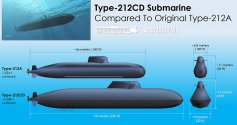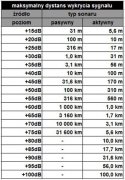I have to caution that when you say background level it refers to the total background sound power, not the spectral power density.I agree with the general direction of your comment but few technical corrections and explanations are necessary for a more complete picture:
1. This "obsession" is the most fundamental thing in submarine warfare.
In surface ASW helicopters and planes can test the unindentified contact with buoys. If it's an allied sub they will have procedures to identify it even if they do not have the signature. If it's not identified and it persists on engagement course you can use small charges to warn it off. You do not have to use lethal force if you are a surface vessel because you do not need to hide your location. You're in the open calling out the other guy hiding underwater : who are you, show yourself.
A submarine can't do the same without revealing its position and once that's done the game for the sub is up. Because of that collecting signatures is the only way in which the submarine can identify targets. If you don't have a matching signature you have an unidentified noise source that may or may not be an enemy ship and considering that there are only so many submarine types in service among many navies of the world it's a mistake you don't want to make. An Indian Kilo, a Russian Kilo and a Vietnamese Kilo won't sound that differently if you have to guess which is which.
2. Not just the west but Russia and China and everyone else do it as well.
For obvious reasons PLAN doesn't use nuclear subs as standard intelligence tool. There's not enough of them and many are too noisy for effective intel gathering. Americans do it on a regular basis because of the relative stealthiness of their subs. Russians track American carriers and subs as much as possible. Everyone uses static networks and sensors planted at key locations to gather data.
Once China has sufficient number of sufficiently quiet SSNs you will see the same "obsession". There's just no other way. Even if you managed to steal the entire databank from your enemy you need to verify it, and then verify it again, and again because you have no idea if this is legitimate information or deliberate disinformation. So in short - nothing beats your own intelligence gathering and even then it's not perfect.
The background noise level is a factor in determining detection distance.
This is the passive sonar equation:
SL − PL − NL − AG = DT
SL - source level [dB]
PL - propagation loss (energy over distance in medium) [dB]
NL - noise level (background noise) [dB]
AG - array gain [dB]
DT - detection threshold [dB]
For theoretical maximum range DT=0 which then gives us:
SL-NL + AG = PL
PL = 10 log R
where R is the distance at which the wave will expire (propagation loss is equal to wave energy)
R= 10 ^ (PL /10) [m]
Explanation:
Every soundwave is the wave of linear pressure in a given medium. The pressure is generated by energy radiated from the source. For example a propeller physically moves an amount of water creating increased pressure on one side of the blade and a vacuum on the other side which is the source of cavitation.
A wave is energy propagating in a specific pattern creating a distortion of the medium. This distortion has specific characteristics with which we describe a wave - phase, frequency, amplitude, polarity etc. The distortion is in the behavior of particles that form that medium - here: molecules of water.
The medium at background state has some kind of behavior and an energy level describing it. Then the wave enters the medium and that behavior changes wherever the wave propagates. It's all about the movement and energy of the particles that make the wave possible.
If the particles at "background state" have low energy then a high energy wave can travel very far before it looses its energy by interacting with the inertia of the medium. This is why gamma rays in space travel for lightyears. Not only it's the most energetic wave but there's no background energy to counter it.
In water the acoustic pressure wave (soundwave) has plenty of particles that have their own energy which is why the usual soundwave travels for hundreds of thousands of kilometers at best. After that its energy is expended and the particles that were acted on by the wave's energy take the energy from the background which is now higher.
That's the background noise.
What the background noise does is limiting the distance at which the wave - a very specific pattern - remains that specific pattern or something sufficiently similar that a computer processing that pattern can say "this is 79,5% general match and 95% specific match to this ship signature".
In short if the background noise is strong enough it doesn't matter how well you know the signature. What you will get is the equivalent of a movie with the sound off- a person's mouth will move but no sound will come out, only the background noise.
If your sub has source level below background noise level the acoustic wave generated by the submarine will immediately be interfered with by the acoustic waves in the background. If background level is greater than source level there is no propagation. No propagation means no signature. No signature means invisibility.
This is why everyone is researching active sonar and distributed sensor networks. The era of listening in silence is over. The era of poking with sticks begins.
Every submarine emits low frequency noise. Just the stretching of the hull during change of depth creates a low frequency wave. The standard frequency range for detection is 5 to 200 Hertz.
5 Hertz is not audible but you can feel it.
The reason why lower frequency noise can be heard at larger distances has to do with whether you can tell the wave apart from the background.
That has to do with characteristics of the wave. High frequency sound is high energy wave. That wave goes everywhere and interferes with the medium turning itself into background noise. High frequency waves are like a swarm of bees and the environment around them behaves accordingly but from afar you can't tell if its a swarm of bees or a cloud or just a shadow. Low frequency waves are looooooooooooong waves. Like snakes. You can always tell it's a snake because it's long.
You can tell the wave apart from the background because it doesn't interact well with it. Quite literally many of the waves that carry you as you swim in water are acoustic waves. They don't hurt at all unless they throw you against something. In contrast high frequency sonar pings can physically hurt and raise the temperature of the diver's body if he's nearby in water.
Parting remark:
Good point on the Bohai Sea. Also note that if you have a secure body of water for testing it becomes the ideal honeypot where the enemy will have to use its actual best capability to gather valuable information. And thus - so will you.
A signal in general can have lower total power than background but higher spectral power density at a particular frequency. This can be seen in a Fourier transform where background has mostly low frequency components while a specific noise source has low amplitude but concentrated at high frequency.


